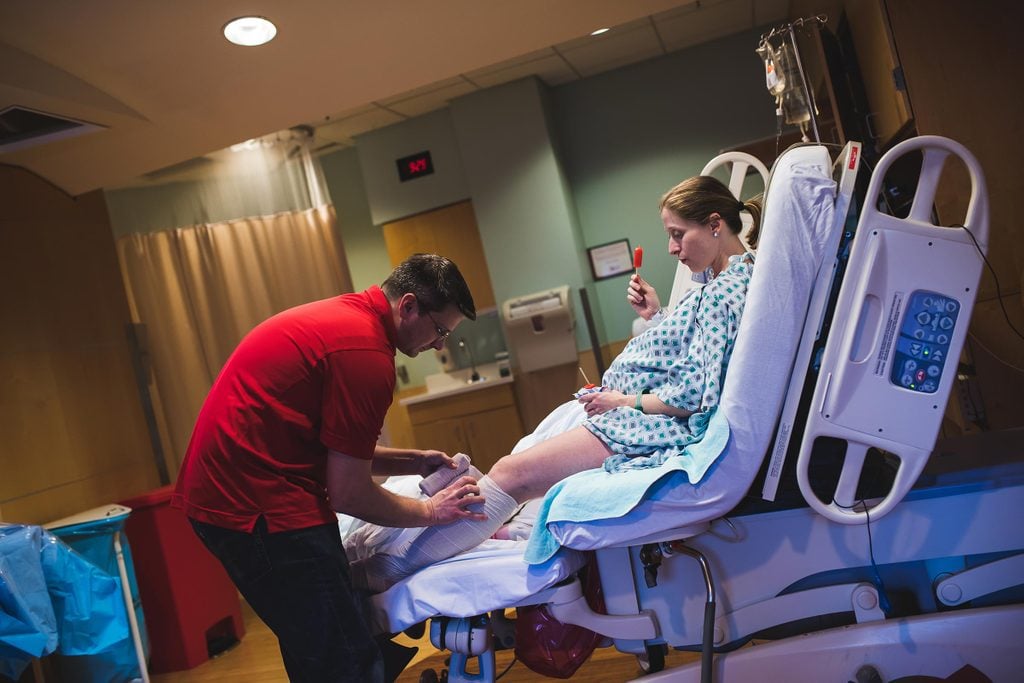This Pregnant Surgeon Didn’t Know She Had a Life-Threatening Condition Until It Was Almost Too Late
Updated: Jan. 18, 2020
Deep vein thrombosis (DVT) affects approximately 900,000 people annually, but the symptoms of these blood clots can be stealthy. Even this medical professional didn't recognize DVT symptoms at first.
 As a surgical oncologist, Mary Dillhoff must carefully concentrate on her patients for long hours in an operating room. She never imagined she could miss a potentially life-threatening condition in herself during her second pregnancy. The active surgeon at the Ohio State University Wexner Medical Center regularly ran marathons and ate a healthy diet, so when she began having shortness of breath, she shrugged it off as third-trimester pregnancy symptoms.
As a surgical oncologist, Mary Dillhoff must carefully concentrate on her patients for long hours in an operating room. She never imagined she could miss a potentially life-threatening condition in herself during her second pregnancy. The active surgeon at the Ohio State University Wexner Medical Center regularly ran marathons and ate a healthy diet, so when she began having shortness of breath, she shrugged it off as third-trimester pregnancy symptoms.
“I was very active and ran a full marathon at 26 weeks pregnant. I ran a 5K even pushing my two-year-old in a stroller during the race, the day before my symptoms started, around my 33rd week,” Dr. Dillhoff says. “I downplayed my symptoms, attributing it to my pregnancy. However, the shortness of breath was significant enough that I could no longer run, and was short of breath simply carrying on a conversation,” she recalls.
 It wasn’t until two weeks later that the symptom she knew she could not ignore appeared. “After traveling in a car for several hours, I looked down at my left leg and it was blue and swollen from my hip to ankle,” she explains. “I knew immediately then I had a DVT [deep vein thrombosis, a blood clot that forms within one of the deep veins in the body, usually the legs] and likely had a pulmonary embolism a few weeks prior that caused my shortness of breath. I went to the hospital for care that night and began blood thinners. At this point, I was walking with a severe limp and had debilitating hip pain.”
It wasn’t until two weeks later that the symptom she knew she could not ignore appeared. “After traveling in a car for several hours, I looked down at my left leg and it was blue and swollen from my hip to ankle,” she explains. “I knew immediately then I had a DVT [deep vein thrombosis, a blood clot that forms within one of the deep veins in the body, usually the legs] and likely had a pulmonary embolism a few weeks prior that caused my shortness of breath. I went to the hospital for care that night and began blood thinners. At this point, I was walking with a severe limp and had debilitating hip pain.”
The swelling continued and didn’t improve over the next two weeks. At this point, given the severity of her symptoms and lack of improvement on blood thinners, her vascular surgeon and obstetrician recommended Dr. Dillhoff have surgical treatment for her DVT, but there was a catch: Having it while pregnant would have been very dangerous for her unborn baby. So at 37 weeks (considered full-term), Dr. Dillhoff was induced.
“My biggest fear that day was dying. I’m a surgeon myself and have seen many people with DVT and pulmonary embolism, but I was as scared as I’ve ever been the day I went in for induction. I was so worried about the baby and my long term health at that point.” Thankfully, the birth happened without a hitch and her newborn son, Jackson, was perfectly healthy.
After being released from the maternity ward of the hospital, Dr. Dillhoff was readmitted to a heart hospital five days after giving birth for treatment of her life-threatening DVT. A catheter was placed into the vein and medication was given to help break up the clot. “This was done for 24 hours and then a stent was placed,” she says; doctors had discovered that she had May-Thurner syndrome—the large right iliac artery in her groin was compressing her left iliac vein. The condition raises the risk of blood clots.
Since her newborn son was only days old, Jackson went with her to the new hospital and stayed by her side. “He got all kinds of attention from the nurses since they were used to a much older population and never really have babies over there,” she recalls.
After receiving the stent, her condition quickly improved. She recalls, “The swelling in my leg was better immediately. I went home after two nights and was running within a week.” Dr. Dillhoff remained on blood thinners for six months past her original diagnosis date.
According to the U.S. Centers for Disease Control and Prevention, 900,000 people annually are affected by blood clots, and 10 to 30 percent of those affected will die within one month of diagnosis. The risk of developing deep vein thrombosis is four to five times greater during pregnancy, and symptoms of the potentially deadly condition include sudden shortness of breath, swelling and pain in one or both legs, leg cramps, chest pain during breathing or coughing (that may produce blood), dizziness and faintness, and rapid pulse. The CDC reports that sudden death is the first symptom for a quarter of all DVT cases, a chilling statistic that highlights the importance of awareness of the condition. DVT symptoms can often masquerade as other conditions, and awareness of the dangerous condition is key.
Dr. Dillhoff explains, “It is very serious and I knew how serious it could have been. The risk of death from a pulmonary embolism is about 10 percent, so I knew this was a big deal.” Though death is a concern, the effects of a blood clot can stay long after the condition has been resolved. Dr. Dillhoff says, “With a clot in the leg, a significant portion of patients get post-thrombotic syndrome, which causes swelling and pain. I was concerned I would no longer be able to function normally and work as I had or take care of my kids, let alone run like I was accustomed to.” Today, Dr. Dillhoff is grateful for her complete recovery. She says, “Our life is really back to normal. We are so lucky to have gotten the care we got and had a great outcome.”
Although anyone can develop a deadly blood clot, pregnant women in particular need to pay careful attention to any painful swelling of the legs, as their risk is greater and pregnancy can often mask the subtle symptoms of the condition. (Here are pains you should pretty much never ignore.)
